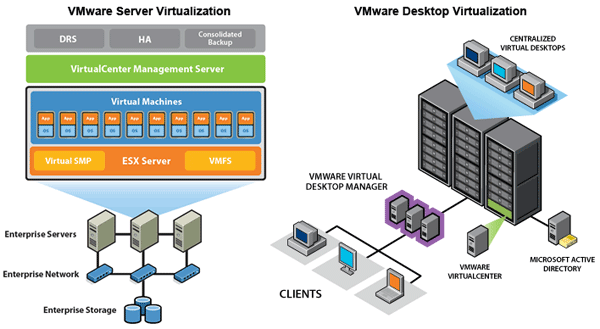KERNEL - VIRTUALIZATION SOLUTIONS
What is Virtualization?
Virtualization is an extraordinary innovation that allows companies to take advantage of the ever-increasing power of computing hardware. It lowers operational costs and increases revenue by optimising every aspect of the infrastructure.
Server virtualization represents the sharing and partitioning of the resources of a physical server into smaller virtualized servers that run independently of one another.
Desktop virtualization represents the migration of the end-user workload from a traditional PC to a virtual instance housed inside the datacenter.
Why Virtualization?

Virtualization brings significant business, cost, and operational benefits to a company. Below are some of the most important ones:
- Cost-saving, server consolidation, and efficient utilisation of resources: use more virtual machines under the same physical host.
- More efficient disaster recovery mechanisms for backup and restore.
- Increase resiliency for the data and applications.
- Reduce power consumption and datacenter footprint.
- There is only one common management interface.
- Near instantaneous virtual machine deployment.
- Dynamic capacity, resource allocation, and application performance increase.
- Easy upgrade for the hardware and application migration.
- Increase user productivity due to proper resource allocation for desktop virtual machines.
- Complete mobility for the users since their virtual desktops can be accessed from any authorised client and the user is no longer linked to the legacy PC.
Virtualization Challanges:
- Hardware resources: Hardware resources: The selection, deployment, and allocation of the resources (servers, storage, networking, SAN, backup) must be well planned and designed in order to be compliant with the performance requirements and expansion plans.
- Technical support: In order to ensure a predictable and error-free operation, the support must be performed by a highly experienced and certified company, and Kernel can provide you with a complete support offering.
- Disaster recovery: Well-designed backup and restore mechanisms must be put in place to ensure that data is consistent and recoverable in case of an incident.
- Management solution: Due to the way a virtual environment works, all operations must be made using a dedicated management platform. Any problem in the design or operation of the management platform can significantly impact the infrastructure and make it unusable.
- Physical to virtual: Conversions: The migration of the applications must be done after careful analysis and testing to ensure that the legacy applications can work and operate in the virtual environment.
- Application response times - Certain types of applications are sensitive to response times and need special care for deployment others are not recommended for virtual environment deployment.
- Clustering and virtual machine live migration: It adds complexity to the design while at the same time ensuring that hardware failures or performance issues are not affecting the responsiveness and availability of the applications in the virtual environment.li>
- CyberSecurity: Information is a valuable asset that must be well protected inside the virtual environment by using a multi-layer security mechanism.
- Storage Area Network: There must be provision to the level required by the virtual environment to ensure optimal performance and response time, and the design must be scalable in order to support the addition of new virtual resources.
Kernel Solutions:
Server virtualization and consolidation promise to help organisations reduce costs, increase agility, and reduce energy consumption. However, implementing virtualization is complex and can appear daunting.
In order to avoid hazards and ensure a smooth transition to the virtualization environment, we use the following approach:
- We are performing an extensive IT infrastructure analysis and evaluation in order to have input data for the project.
- We evaluate the present load of the infrastructure, the applications and their data, business processes, and work flows.
- We conduct interviews with decision-makers, management and administration, and regular users in order to assess the present user experience, identify issues that are present, and determine the expected outcome of the project and acceptance conditions.
- We conduct extensive analysis of the applications that should be migrated to the virtual environment in order to determine which ones can or cannot be virtualized.
- We designed a virtualized architecture that includes hosts, storage, backup and restore (BAR), networking, and management, and we estimate the return on investment (ROI).
- If the need arises, we conduct a pilot or test implementation in order to validate the design and test critical applications in a virtual environment.
- The implementation is performed in accordance with the design and project plan.
- Optimisation, customization, and tuning are needed to ensure the optimal usage of resources and the best level of performance.
- The project is accepted into production, and post-implementation support starts.
- Planned and executed required engineering tasks and business processes.



